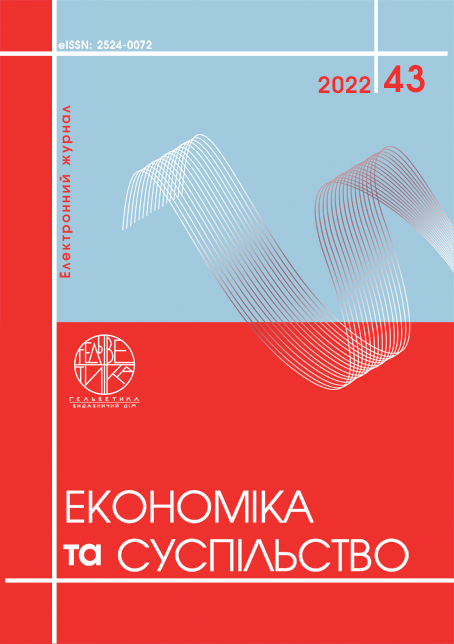IMPACT OF SECTORAL SATURATION WITH FOREIGN INVESTMENTS ON ECONOMIC DEVELOPMENT OF OECD MEMBER COUNTRIES
Abstract
The article analyzes the impact of foreign capital involved in a certain sector on the development of the economies of host countries. The high level of geopolitical tension in the world, the simultaneous crisis in the energy and food markets, the volatility of world prices for the rest of the commodities, the high probability of "cooling" of the world economy and the consequences of the war in Ukraine form the prerequisites for a significant decrease in international flows of foreign investments. Due to the increased competition for them among the countries of the world, the urgency of determining those sectors of the economy of the host country, in which the functioning of foreign capital gives the greatest impetus to the development of the entire national economy, compared to other sectors, is rising. This issue will be especially acute for the Ukrainian state at the stage of its post-war recovery, taking into account the negative impact of the significant scale of destruction and security risks on the investment attractiveness of our country. Based on this, the task of the research was to carry out a quantitative assessment of the impact of the saturation of sectors with foreign investments on the economy of countries, the level of development of which can serve as a reference point for Ukraine in the process of post-war reconstruction. To do this, the density of the connection between the mentioned economic phenomena in the OECD member countries was investigated using general scientific methods and statistical analysis. The obtained results made it possible to differentiate the sectors according to the influence of the foreign capital invested in them on the economic activity of the host country. This made it possible to single out groups of sectors in which foreign investments have a strong, moderate or weak effect on the growth of national economies. The experience of the functioning of foreign capital in the economies of the OECD member countries shows that the greatest impact on the activity of the economic development of the host country is the involvement of the mentioned capital in the sphere of services, finance, as well as in research activities. Next in this ranking in terms of the power of stimulating influence is a group of sectors consisting of IT, processing industry, transport and trade. The effect of foreign investors' activities in the extractive industry, hotel and restaurant business, real estate and energy supply sectors of the above-mentioned countries turned out to be the smallest or least noticeable for the economic development of the OECD member countries.
References
Савант, Карл П., Хамдані К. An International Support Programme for Sustainable Investment Facilitation. Міжнародний центр торгівлі та стійкого розвитку, 2015. С. 3–5. URL: https://ssrn.com/abstract=3143372
Кляйн Дж. Regional Partnership to Promote Trade and Investment in Sub-Saharan Africa. Ініціатива міст тисячоліття, 2014. С. 17. URL: http://mci.ei.columbia.edu/files/2014/08/FinalMCI_PSD_Narrative_ReportAugust2014.pdf
Ечанді Р. Connecting the dots between International Trade & Investment Regulation, Investment Climate Reform & Development: The World Bank's Investment Reform Map. Світовий банк, 2015. С. 32. URL: https://www.researchgate.net/publication/335079140_Connecting_the_dots_between_International_Trade_Investment_Regulation_Investment_Climate_Reform_Development_The_World_Bank's_Investment_Reform_Map
ЮНКТАД World Investment Report 2022. ЮНКТАД, 2022. С. 22–23. URL: https://unctad.org/publication/world-investment-report-2022
Світовий банк. URL: https://data.worldbank.org/indicator/NY.GDP.PCAP.CD?most_recent_year_desc=false
Департамент ООН з економічних та соціальних питань. Підрозділ статистики (2008) International Standard Industrial Classification of All Economic Activities, Revision 4 URL: https://unstats.un.org/unsd/publication/seriesm/seriesm_4rev4e.pdf
ОЕСР Дані. URL: https://stats.oecd.org
Sauvant, Karl P., Hamdani K. (2015) An International Support Programme for Sustainable Investment Facilitation. International Centre for Trade and Sustainable Development (ICTSD), pp. 3–5. Available at: https://ssrn.com/abstract=3143372
Kline J. (2014) Regional Partnership to Promote Trade and Investment in Sub-Saharan Africa. Millennium Cities Initiative, p. 17. Available at: http://mci.ei.columbia.edu/files/2014/08/FinalMCI_PSD_Narrative_ReportAugust2014.pdf
Echandi R. (2015) Connecting the dots between International Trade & Investment Regulation, Investment Climate Reform & Development: The World Bank's Investment Reform Map. World Bank, p. 32. Available at: https://www.researchgate.net/publication/335079140_Connecting_the_dots_between_International_Trade_Investment_Regulation_Investment_Climate_Reform_Development_The_World_Bank's_Investment_Reform_Map
UNCTAD (2022) World Investment Report 2022. UNCTAD, pp. 22–23. Available at: https://unctad.org/publication/world-investment-report-2022
Worldbank Data. Available at: https://data.worldbank.org/indicator/NY.GDP.PCAP.CD?most_recent_year_desc=false
UN Department of Economic and Social Affairs Statistics Division (2008) International Standard Industrial Classification of All Economic Activities, Revision 4 Available at: https://unstats.un.org/unsd/publication/seriesm/seriesm_4rev4e.pdf
OECD Data. Available at: https://stats.oecd.org


